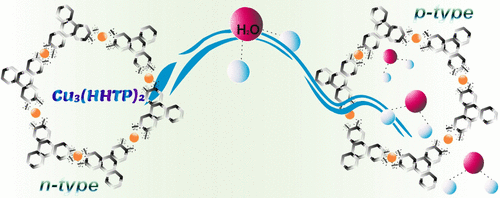当前位置:
X-MOL 学术
›
ACS Appl. Mater. Interfaces
›
论文详情
Our official English website, www.x-mol.net, welcomes your
feedback! (Note: you will need to create a separate account there.)
Tunable Carrier Type of a Semiconducting 2D Metal–Organic Framework Cu3(HHTP)2
ACS Applied Materials & Interfaces ( IF 8.3 ) Pub Date : 2022-03-01 , DOI: 10.1021/acsami.2c00089
Maria de Lourdes Gonzalez-Juarez 1 , Carlos Morales 2 , Jan Ingo Flege 2 , Eduardo Flores 3, 4 , Marisol Martin-Gonzalez 3 , Iris Nandhakumar 1 , Darren Bradshaw 1
ACS Applied Materials & Interfaces ( IF 8.3 ) Pub Date : 2022-03-01 , DOI: 10.1021/acsami.2c00089
Maria de Lourdes Gonzalez-Juarez 1 , Carlos Morales 2 , Jan Ingo Flege 2 , Eduardo Flores 3, 4 , Marisol Martin-Gonzalez 3 , Iris Nandhakumar 1 , Darren Bradshaw 1
Affiliation

|
In this work, a switch from n-type to p-type conductivity in electrodeposited Cu3(2,3,6,7,10,11-hexahydroxytriphenylene)2 [Cu3(HHTP2)] has been observed, which is most likely due to oxygen molecular doping. The synthesis of electrically conductive 2D metal–organic frameworks (MOFs) has been achieved through the introduction of highly conjugated organic linkers coordinated to their constituent metal-ion centers. However, the porous structure and unsaturated metal sites in MOFs make them susceptible to ambient adsorbates, which can affect their charge transport properties. This phenomenon has been experimentally investigated by GIXRD, Hall effect and Seebeck measurements, and X-ray photoelectron spectroscopy.
中文翻译:

半导体二维金属有机框架 Cu3(HHTP)2 的可调谐载流子类型
在这项工作中,观察到电沉积 Cu 3 (2,3,6,7,10,11-六羟基苯并菲) 2 [Cu 3 (HHTP 2 )]的导电性从 n 型转变为 p 型,这是最常见的。可能是由于氧分子掺杂。导电二维金属有机框架(MOF)的合成是通过引入与其组成金属离子中心配位的高度共轭有机连接体来实现的。然而,MOF 中的多孔结构和不饱和金属位点使其容易受到环境吸附物的影响,从而影响其电荷传输特性。这种现象已通过 GIXRD、霍尔效应和塞贝克测量以及 X 射线光电子能谱进行了实验研究。
更新日期:2022-03-01
中文翻译:

半导体二维金属有机框架 Cu3(HHTP)2 的可调谐载流子类型
在这项工作中,观察到电沉积 Cu 3 (2,3,6,7,10,11-六羟基苯并菲) 2 [Cu 3 (HHTP 2 )]的导电性从 n 型转变为 p 型,这是最常见的。可能是由于氧分子掺杂。导电二维金属有机框架(MOF)的合成是通过引入与其组成金属离子中心配位的高度共轭有机连接体来实现的。然而,MOF 中的多孔结构和不饱和金属位点使其容易受到环境吸附物的影响,从而影响其电荷传输特性。这种现象已通过 GIXRD、霍尔效应和塞贝克测量以及 X 射线光电子能谱进行了实验研究。

































 京公网安备 11010802027423号
京公网安备 11010802027423号